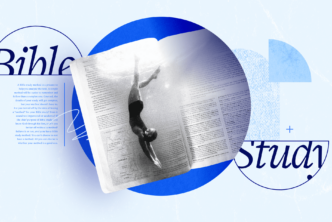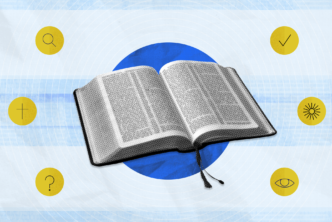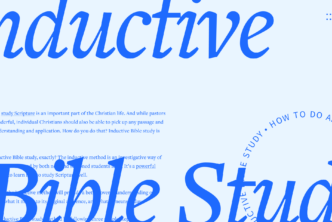A while back, Randy Brown, creator of BibleBuyingGuide.com, shared how he chooses a Bible for preaching. Randy reviews Bibles in all price ranges to help people make the best choice for their budget. His mission is to promote Bible reading and study, and to share quality publishing. After spending a couple months with the Faithlife Study Bible, here’s what he has to say.
***
I’ve been an electronic Bible user for a long time. I try different brands and Bibles because there are specific features that I like from each of them. Recently I tried out the Faithlife Study Bible.
I have always looked for a certain set of features. I want the ability to change the font style, to perform searches easily, to take notes, to highlight the text, to create my own memory list, and to create my own study Bible. I also want to add Bibles and books. I’ve seen these features before, so I thought the Faithlife Study Bible couldn’t surprise me. I was wrong. It has features I didn’t know existed, and some of them, I can’t live without.
Groups
The ability to have groups is interesting. You can search for groups by city and by church or denomination, or start a group with your friends. You can receive notifications of group activity and messages from group members. Another thing I found interesting was the news feed: you can publish a message for group members and it will show up in the group’s feed. I can see this being valuable for study groups, men’s or women’s groups, pastors, students, and teachers. Group members can help each other grow and hold each other accountable.
Notes
The notes had some features I didn’t expect. Normally I just click to add a note and it’s attached to a specific verse and that’s it. Some apps also let you view all your notes independently of the Scriptures.
The FSB lets you apply colors and symbols to the note. You can sort the notes by reference, date added (oldest or newest), title, or note color. This is significant for me because I like to color-code according to topic. Being able to color-code my notes and then sort by color means I can see all of my notes based on the specific topic I’m studying or teaching on. Also, you can add notes to a verse (across all translations) or to a specific word in the verse.
I also like the way you navigate to your notes from the main menu. When you click on notes in the menu, you get a list of categories. Within these categories are the individual notes that you’ve placed under that title. You can easily move the note from one category to another. This is a great feature for building a sermon or classroom lesson that you can preach or teach directly from your device.
To get you started there are a few categories already created: Inductive, Emphasis Markup, Highlight, and Solid Colors. There’s nothing in them (these are your notes, not someone else’s) but the categories help get you thinking.
The notes sync across every device that you sign in with, so if you have a phone and a tablet, they will both have the same notes regardless of which device they were created on. The electronic Bibles that I’ve used were stand-alone apps that would let me highlight and create notes to my heart’s content, but they only lived on one device. I could make a backup, but it was a hassle to move all those notes. The notes in this app back up and run on your other devices with no effort on your part.
This feature will let me make my own personal study Bible. I’ve always wanted to do this, but I always hesitated because I knew it would be a nightmare to switch devices.
Community Notes
FSB notes can be private, public, or connected to a group, so you can share them if you want. This is a nice feature because it helps us learn from others. This can also be used for classes because my students can easily access my notes.
Favorites
I love using bookmarks to keep my Scripture memory list. The FSB takes favorites further than bookmarking Scriptures—you can even favorite your own notes. The ability to favorite notes is perfect for preaching or teaching. “Favoriting” a verse or note is easy—just click on the star and choose from the list on the screen. It’s both intuitive and valuable.
When you go to your favorites, you see a list of verses and notes. You can scroll down the screen and click to go to a verse. When you go back to the favorites list, it saves your place, so you don’t have to scroll back to where you were in the list.
Highlights
I love highlighting my Bible. I’ve used many highlighting features in electronic Bibles, but the FSB has by far the best options I’ve ever seen. It’s great for marking memory verses, passages for sermons, topics, and more.
There are three main ways to highlight in the FSB:
- You can highlight based on emphasis. This gives you lots of options to mark up the text, including underlining, bold, flaming text, orange outline, shadow, large font, and more.
- You can highlight the text with a selection of nine different colors. They make the verse look like they were marked by hand. I love print Bibles, so I love this hand-marked look. You highlight can the font itself (with nine color options), which will change the color of the fonts themselves, or highlight the text (six options).
- And then there’s my favorite—the most unique highlighting option: inductive. There are 34 inductive marking symbols. This is a great way to try your hand at the inductive study method without having to invest in the markers, a Bible to mark in, and the time it takes to do the marking by hand. You choose the highlight and you’re back to the important part—the Bible study.
The highlighters also work together in layers. You can select a single word, color the font, make it bold, and place an inductive symbol over it. You can also delete the highlights individually. I’m used to highlighting systems that only give me one highlight or the other. The options here are astounding.
On the highlight screen you get a list of all your highlights individually. This includes the words and passages that you’ve highlighted.
Just like your own notes, your highlights are available on every device that you sign in with, regardless of which device they were created on.
Presentations
If your church uses Proclaim, this allows you to follow the service on your phone or tablet. When your pastor references a verse or passage, your mobile device automatically brings it up for you.
Searching
The search feature is one of the things that makes a digital Bible so useful. Again, the FSB takes it a step further by letting you not only search the Bible, but also letting you search “Bible and notes,” your entire library, top Bibles, recent resources, the Lexham English Bible, and FSBI (FSB infographics). The search is extremely fast and loads more results as you scroll.
Downloads
You can expand the FSB with additional downloads. Free downloads include infographics, photos, and videos. They’re easy to download and use. The maps are well annotated and are great for study and sermon prep. The downloads all make great study and teaching material, especially if you can connect your device to a screen for others to see. You can also purchase other translations and books.
Lexham English Bible
I use lots of translations. I mostly use KJV, NKJV, and ESV. I occasionally use NASB, HCSB, and a few others. I lean toward more literal translations. The LEB (which comes free with the FSB) is a very literal translation. I like that supplied words are marked. They’re needed for correct grammar, but I like knowing what’s in the original languages and what has been supplied to maintain correct grammar. Overall, I found the LEB to be very readable and useful in study.
Study notes
The study Bible portion of the FSB has enough notes to keep you busy for a long time. The scholarly notes include articles, devotionals, Hebrew and Greek word studies, theological commentary, cultural and historical information, and lots more. They also contain clickable cross-references. Obviously there will be some theological bias (my notes do too), so I recommend you do your own study and use the notes for reference.
Overall operation
The FSB lets me navigate to any verse I wanted, add notes and highlights, and much more. Navigating through my own notes from the split screen was difficult at times—I wanted to swipe to the side to go from one note to another, but this motion attempts to delete the note. Fortunately it is easy to undo. Other than that, the app was pretty intuitive. I finally did get the hang of navigating through my own notes, and I couldn’t be more pleased with how it operates.
Final thoughts
The Faithlife Study Bible is solid. It has far more features than I expected to see in a free Bible app. And they’re not just features for features’ sake—they’re useful. In fact they’re so useful that you’ll wonder how you got by without them.
I especially like the Community Notes and highlighting features. I would choose the FSB for these features alone.
* * *
Get your free copy of the Faithlife Study Bible now. Want to see how Randy Brown from BibleBuyingGuide.com chooses a Bible for preaching? Check it out.





